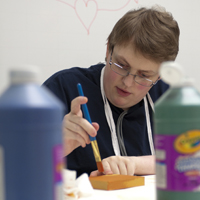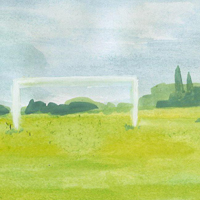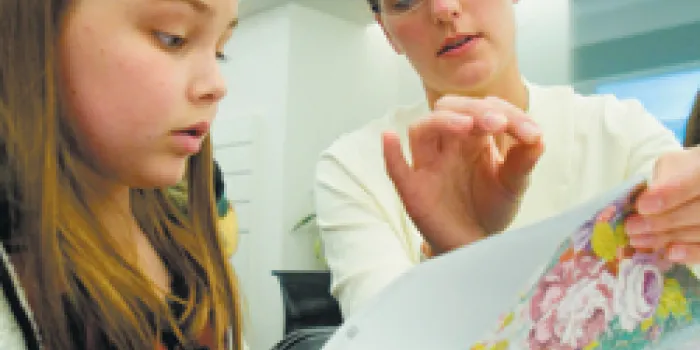When Ramiro Gomez was a freshman in high school, he was already starting on the varsity soccer squad in his hometown of San Bernardino, California. Gomez, who has mild to moderate hemophilia A, dreamed of becoming a professional player and having the talent to back those dreams.
Gomez’s passion for soccer subjected his thighs and knees to repeated injuries. However, his family, and his larger Mexican-American community, did not have a lot of information about hemophilia or the benefits of prophylaxis at the time. Therefore, his treatment was reactive, not proactive. Like many competitive athletes, he powered through. “There was a lot of pain, but I would get right back on the field,” says Gomez, now 24.
In Gomez’s sophomore year of high school, getting back in the game became more difficult with each injury. During long bouts in the hospital to treat knee bleeds and bruised, swollen thighs, he turned to a newly discovered outlet—art. “The only thing I could do in the hospital was draw or paint,” says Gomez. “I painted because I was mad. It helped me cope.”
Gomez didn’t know it at the time, but he was doing his own form of self-administered art therapy. He was using a creative outlet to keep his mind off his physical pain and to release his emotional pain.
For people with bleeding disorders and their families, art therapy can be a helpful complement to treatment. “Art therapy is appropriate for all ages, and it can be done individually or in a group,” says Tamara Shella, art therapy program manager for Cleveland Clinic’s Arts & Medicine Institute in Ohio. “It doesn’t require artistic talent or ability, just the willingness to give it a try.”
The Basics of Art Therapy
Art therapy is a mental health profession. Practitioners complete a master’s degree program in art therapy and perform postgraduate work. Typically they have experience in both the arts and mental health fields. Art therapists are registered with and can become board-certified through the Art Therapy Credentials Board, based in Greensboro, North Carolina.

Cleveland Clinic’s Arts & Medicine
A teenager at Cleveland Clinic’s Arts and Medicine Institute is using inks to design a ceramic tile.
Art therapy can help people open up to resolve conflicts. It can also help people develop interpersonal skills, manage behavior and reduce stress. It can increase self-esteem and self-awareness, and help people achieve insight, according to the American Art Therapy Association, a membership organization based in Alexandria, Virginia, of art therapy professionals dedicated to the use of art for healing and life enhancement. Shella sometimes works with patients in a group setting. They will hang a finished piece of art on the wall and “process” it together out loud. Questions that spark discussion include, “What do we see in it?” and “Do the colors and objects represent anything?”
Art therapist Tracy Councill says that even if people are shy or unwilling to share their feelings, simply creating something in the first place offers its own therapy. “Creative work gives people a sense of control they may not feel when they’re dealing with a serious condition,” she says. Councill founded an art therapy program at Georgetown University Hospital’s Lombardi Cancer Center in Washington, DC, in 1991. She also founded Tracy’s Kids, a nonprofit program that offers art therapy to more children in the greater DC area.
The Benefits of Creativity
Shella and Councill both stress that art therapy isn’t about producing masterpieces; it’s about the creative process. The benefits of that process can be as diverse as the people who go through it.
For one thing, art can distract people from chronic pain by engrossing them in an activity that is inherently relaxing and that eases stress. Such was the case for Joey Procopio, a child who worked with Councill.
[Steps for Living: The Pain Facts]
Joey was diagnosed with leukemia in 2003 when he was 5 years old. A couple of years into his cancer treatment, he was diagnosed with type 1 von Willebrand disease. Faced with visit after visit to Georgetown University Hospital, Joey found a welcome reprieve in his work with Councill. “It was wonderful for Joey to come in and not have to think about why he was there,” says Joey’s mother, Julie. In addition, he benefited by participating in a group. “They would sit together working on projects while hooked up to an IV of some sort, or getting a blood transfusion, but they would have smiles on their faces.”
Pottery became Joey’s preferred artistic pursuit. “He went in there and sculpted, and then the piece had to dry,” his mother says. “It gave him something to look forward to the next time he went in.” After it dried, the pottery had to be fired and then glazed. “After all these visits, there was a finished product that took time,” says Julie. Now, eight years later, and with Joey’s leukemia in remission, the pieces of pottery displayed throughout her house are reminders of just how much art therapy helped her son.
Julie also saw the benefit of art therapy for Joey’s older sisters, Melissa and Rachael. The diagnosis had been difficult for them. Their art sessions offered calmness and a way to stay busy while Joey was being treated. Further, Julie experienced the benefits of being part of a community. “Standing in the art room with other parents, patients and kids, I knew that everybody understood what I was going through,” she says.
Art therapy can also help people work through the anxiety that comes with routine medical procedures, such as self-infusion. For example, if a newly diagnosed person is afraid of needles, Shella might recommend drawing a “pain monster,” or even a needle itself. “That way he can talk about the needle on the paper even if he is afraid of talking about the actual needle,” she says. In turn, stress goes down. When stress subsides, pain levels tend to fall, too. “If you’re expecting something to be very painful and awful, your anxiety rises,” Councill says. It can become a self-fulfilling prophecy. “We try to help people gain a sense of control and not let anxiety get out of hand,” she says.
[Steps for Living: Teaching Kids About Self-Infusion]
Finding the Right Medium
When Gomez’s injuries were the most painful, his medium of choice was watercolor painting, in large part because of its gentle physical nature. When he had trouble walking and bending his legs to sit,

his dad made him a small easel to stand next to his bedside. “Whenever I was injured, I could work at my bedside,” Gomez says. “Watercolors just require a little wrist motion, unlike the harder motion of putting pencil to paper.” Painting helped him get through some painful periods when he was bedridden.
For others, creating crafts out of tissue paper or making jewelry might be better outlets. Whatever the medium, finding a creative way to help manage a serious condition is what counts, Councill says. “We’re here to help people articulate how they feel,” she says. “We also help people keep hope alive and put things in perspective.”
During high school, Gomez attended summer art programs. He earned scholarships to the California Institute of the Arts in Santa Clarita. Now a professional artist working under the name Jayzie, Gomez has displayed his work in several exhibitions, using a variety of media. He’s now on prophylaxis and plays soccer in local leagues. When Gomez is sidelined by an injury or bleed, he still paints melancholy soccer scenes.

